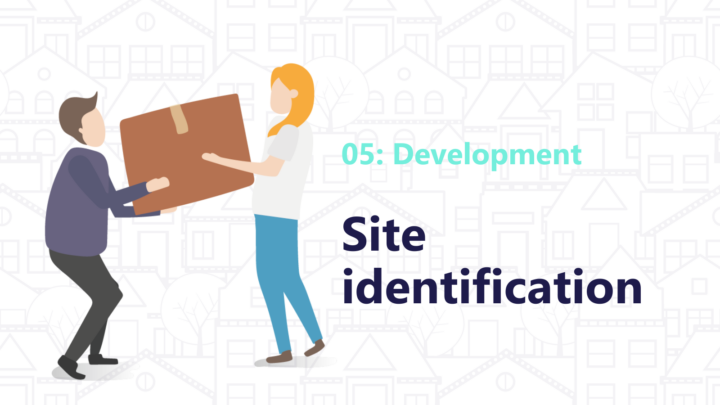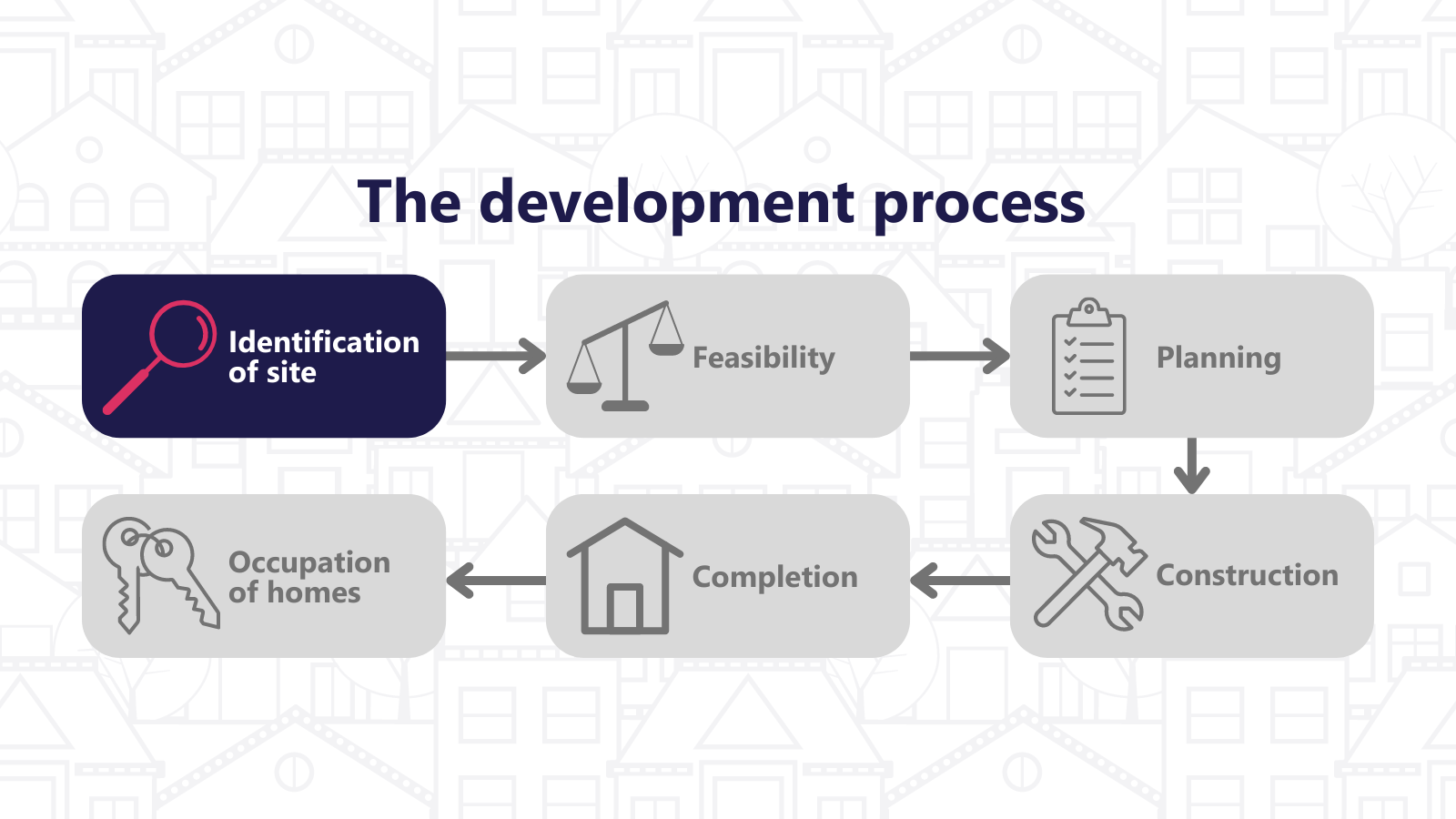Site identification


There are a number of factors to consider when undertaking the process of selecting a site to develop for a new community-led homes development, but these begin with defining the criteria and considerations for identifying the site before any appraisal or assessment work is undertaken. As such, consideration should be given to the following which will also be an integral part of the client project brief:
• Define the requirements of the development
• Define the housing need
• Geographical area of search
• Site location requirements
• Site size
• Land or existing building
When searching for a site assuming that it is not already in the ownership of the group promoting the project, there are numerous sources of both a formal and informal nature that exist to initiate a search based on the site identification criteria. These include:
• Landowners willing to engage with community-led housing groups
• Estate Agents
• Developers
• Contractors
• Land Development Consultants
• Adverts and auctions
• Local knowledge and networks
• Local Development Plan allocations
• Public Sector Land Disposal, e.g. local authorities, government departments, health boards
• Church denominations who have land or property that is surplus to requirements
• Area-based regeneration schemes
It is likely that the site identification and search exercise will reveal a number of potential opportunities and so it will be necessary to undertake initial site appraisal work to review the sites and identify a preferred option to take forward to more detailed assessment and a full feasibility study. It will be important that the information collated on the various sites is retained and recorded for future reference in justifying the preferred site selection choice and decision, but it will also be useful for future development aspirations or in the event that for one reason or another the preferred option is unable to proceed. As such, the early stages of the development process around site identification, assessment, appraisal and feasibility are iterative exercises as the considerations move from initial review to more detailed appraisal.
This appraisal stage is a key building block of developing and determining the feasibility and viability of a development site and suitable time and resources need to be committed to full and proper research and assessments. It will involve a combination of desktop research around, for example, housing needs, planning policy and flood risk together with fieldwork comprising site visits and walkovers, surveys and ground condition investigations, all with the aim of building up the knowledge and intelligence on a site to enable an assessment of financial viability using four ‘pillars’ of due diligence of a technical, legal, planning and commercial nature.
Given that this is an evolving stage and process, very early decisions with limited if any financial resource commitments can assist in refining the number of options available. It is important to recognise at an early stage the ability to as much ‘rule out’ as ‘rule in’ potential development sites in order that possible abort time and costs are minimised.
In summary, the site appraisal and assessment stage will need to consider the following:
• Physical features
• Planning
• Design
• Costings
• Funding
• Viability
• Due diligence – technical, planning, legal, commercial
• Site reconnaissance, survey and desktop research
In practical terms, a simple checklist can be devised to undertake the assessment and appraisal of site options which combines both desktop and fieldwork components. Some of the questions that a checklist could address include:
• How much is the asking price and who is the owner/vendor?
• Is it freehold or leasehold?
• Is the size appropriate? How big is it?
• What is the current and former uses of the site/property?
• Is it a site or existing building? If a building, what is state of repair and is it suitable for residential use?
• Is there access on foot and for vehicles?
• Is it in the required area?
• Is it suitable for the identified need?
• Are there amenities nearby?
• Is residential planning consent existing or likely?
• Are services available?
• Are there any physical constraints?
• What is the site aspect and orientation?
• Is there a risk or history of flooding?
• Is the site greenfield or brownfield?
• Are the boundaries well defined?
• Are there any conditions of sale?
From this initial assessment, it is anticipated that a preferred site option is identified and that more detailed survey and investigation is required to appraise the site and to inform the feasibility study. This will include the commissioning of external advice and support to address some or all of the following:
• Site visit and walkover
• Topographical survey
• Ecological survey
• Geotechnical (desktop and intrusive site investigation)
• Flood risk
• Utilities and services
• Drainage surveys
• Environmental, e.g. tree surveys, bird nesting, water quality
• Legal searches
• Planning appraisals
• Others, e.g. acoustic
The output from these more detailed surveys will be to define the opportunities presented by the site but equally important to define the site constraints to inform subsequent design options in terms of the site dwelling capacity and form of development in achieving the vision and detail of the client project brief. A number of issues need to be considered at this stage:
• Identifying some form of arrangement that locks the landowner in for a given period of time to allow the time to undertake assessments and to commission reports with confidence. For example, the arrangements could include an option agreement or an agreed exclusivity period.
• The assessments should be undertaken on a staged incremental basis such that if a major constraint is identified that would prevent taking the site forward, no further or potentially aborted work and costs are incurred. The ability to ‘rule out and rule in’ is an important and constant consideration during the pre-contract stages of diligence as this ensures that the necessary rigour is being applied and it demonstrates prompt, pro-active and informative activity to a landowner.
• The briefing and commissioning of surveys and reports from external sources of expertise and support will be important at this stage. It should be the case that reports are commissioned as and when necessary and that these reports can meet multiple needs and uses within the project as well as ensuring that the client and potential funders can have reliance on the findings and recommendations of those reports going forward.
The appointment of consultants within the development process is to provide support, guidance and expert professional advice to the client that it might not otherwise have access to within its organisation or group. Such appointments are designed to assist the client in delivering its project aspirations, visions and objectives whether in managing certain aspects of the project on behalf of the client or providing specialist advice or services. Consultants are not appointed to usurp the role of the client but are there to supplement its resources in key areas where such expertise is not available internally.
When considering the selection and appointment of consultants, the following considerations are noted:
• Clarity of client project brief
• Compliant procurement process
• Previous experience and track record of consultant
• Other client references
• Understanding of concept and delivery of CLH schemes
• Fee levels (cost and quality)
• Programme, deadlines and capacity
• Who will work on the scheme within the consultant organisation?
• Insurances, e.g. Professional Indemnity, Employers Liability, Public Liability
• Reliance on report findings and recommendations for client and funder
• Standard Form of Appointment using recognised professional bodies, e.g. RIBA, RICS












